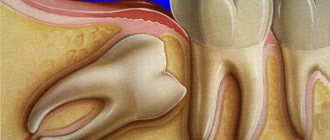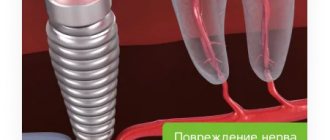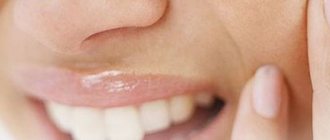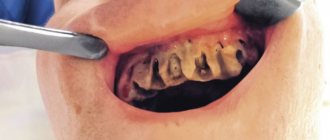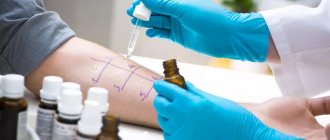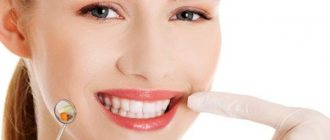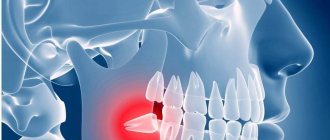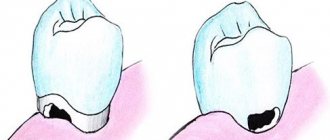My cheek is swollen after dental treatment - what to do?
- Dentistry Kyiv | Dental clinic in Kyiv. Solomenka.
- >
- Articles
- >
- My cheek is swollen after dental treatment - what to do?
Sometimes after tooth treatment (especially after removal and root canal treatment), an alarming picture is observed - a swollen cheek. Moreover, such a picture can be observed even after visiting a highly qualified specialist who did not make a single mistake during the therapeutic procedures. What causes this complication, and how to act when it occurs?
What are the main causes of swelling with pain?
The main cause is inflammatory processes of periodontal tissues, which are caused by a number of pathological conditions.
- Advanced caries, bad habits, ignoring hygiene rules or poor-quality root canal filling. In most cases, swelling of the cheek is preceded by pain localized on the side of the affected tooth. The source of inflammation is located in the root area and after a few days a flux can form, which without treatment transforms into an abscess.
- Very often, swelling of the cheek occurs due to disruption of the eruption of wisdom teeth. In this case, purulent inflammation is caused by the formation of a pocket (hood) between the gum and the dental unit itself. In addition, due to lack of space in the jaw arch, molars can occupy an unphysiological position and injure the buccal mucosa.
- Inflammation caused by infection of the socket after the removal of a molar very often leads not only to swelling of the cheek, but also to more serious consequences.
- A dental cyst is characterized by asymptomatic formation over a long period of time; when it increases to 5-7 mm, the neoplasm presses on the bone. The pathology is characterized by acute throbbing pain, accompanied by swelling and redness of the gums, as well as deterioration of the general condition.
The danger of inflammatory processes in the oral cavity lies in the close proximity of pathogenic swelling to the tissues of the face and brain. If left untreated, there is a high risk of phlegmon and abscess formation, which in extreme situations can lead to death.
When should you make an appointment with a doctor?
Swelling of the cheek is a symptom of an acute inflammatory process, in which you need to urgently seek medical help. Other reasons to visit a dental clinic are:
- redness and looseness of the gum tissue,
- bleeding when brushing teeth,
- constant metallic taste in the mouth,
- discomfort and pain,
- uneven height of the gingival margin,
- exposure of the necks of the teeth,
- discharge of pus from under the gums.
The temperature often rises, appetite disappears, and weakness occurs. These are symptoms of intoxication of the body.
The tooth does not hurt, but the cheek is swollen - the causes of the pathological condition
Very often, swelling is a consequence of an allergy to materials used for filling, prosthetics and treatment of dental units. In addition, the clinical situation may be associated with the body's reaction to food, pollen, dust or pet hair. In this case, the swelling does not have a clear localization and can spread to the area of the nose, lips and eyes. .
It should be understood that after the removal of a tooth, nerve or dissection of the gum, swelling and pain are considered normal and can persist for a week after the intervention. You should also exclude respiratory and viral pathologies accompanied by enlarged submandibular lymph nodes (mumps, pharyngitis), high body temperature, and chills.
Another reason is bruises and injuries to the face; in addition, the cheek may swell due to neurological disorders, for example, inflammation of the nerve. The problem is indicated by pain in the throat and parotid region, hearing impairment, facial expressions and diction.
The appointment includes consultation and drawing up a treatment plan with cost determination
sign up for a free consultation
Not ready for an in-person consultation with a doctor? Ask your question by phone
Why does my cheek swell?
Periostitis of the jaw
It is the most common dental cause of the symptom. Develops against the background of dental diseases: periodontitis, pulpitis, alveolitis, periodontitis, suppurating jaw cyst. It is provoked by open fractures of the jaws, infected facial wounds, operations, and tooth extraction. In some cases, it becomes a consequence of hematogenous or lymphogenous spread of infection from distant foci. Depending on the form, it is accompanied by the following manifestations:
- Acute serous periostitis.
Moderate swelling of the soft tissues of the cheek, redness of the mucous membrane, and enlargement of regional lymph nodes are detected. The general condition suffers slightly, sometimes there is an increase in body temperature to subfebrile levels. - Acute purulent periostitis (flux
)
.
The contours of the face are sharply changed, the predominant localization of edema is determined by the location of the inflammatory focus in the periosteum. Patients complain of sharp pain radiating to the temple, eye, ear, and neck. General hyperthermia, chills, weakness, headache, and regional lymphadenitis are observed. When examining the oral cavity, an area of swelling with a fluctuation in the center is detected - a subperiosteal abscess. - Chronic periostitis.
Slight swelling of the cheek, thickening of the jaw, and enlargement of the submandibular lymph nodes are typical. The patient complains of periodic moderate pain. The mucous membrane of the affected area is swollen, hyperemic, with a bluish tint.
Other dental diseases
Other possible dental causes of cheek swelling include the following:
- Perimaxillary abscess.
It occurs as a result of infection of the soft tissues of the perimaxillary area due to boils, tonsillitis, wounds, abrasions, and some dental diseases. Swelling is preceded by toothache, which gets worse when biting. Then dense swelling appears, the temperature rises, and appetite disappears. After spontaneous opening of the abscess, the condition improves, but subsequently the pathology may recur. - Vincent's stomatitis.
Develops when immunity decreases due to diseases, injuries, and stressful situations. The leading symptom is the formation of multiple ulcers on the mucous membrane. Swelling of the cheek is detected in severe cases of the pathology. - Noma.
An area of ulcerative-necrotic lesions of the lip or oral mucosa appears. Necrosis covers the gums, tongue, cheek tissue, and facial bones. The tissues around the area of necrosis are swollen; in severe cases, swelling from the cheek spreads to the chin and infraorbital area. - Salivary gland adenoma.
The parotid gland is most often affected. Local swelling with clear boundaries forms on the outer surface of the cheek, in the parotid zone, and spreads to the angle of the jaw, the area under the earlobe. Characterized by slow growth, painlessness at the initial stage, progression of discomfort and dry mouth as the formation increases. - Tumors of the salivary glands.
Along with adenomas, benign connective tissue neoplasia, intermediate and malignant neoplasms can form in the area of the salivary glands. The area of swelling is located in the same place as with adenomas. The swelling slowly increases in benign tumors and spreads quickly in malignant ones. - Purulent parotitis.
Swelling occurs in the parotid area, which spreads to the adjacent part of the cheek. There is severe pain, difficulty when trying to open the mouth, severe intoxication, and severe hyperthermia.
Cheek swelling
Traumatic injuries
All facial injuries are accompanied by rapidly increasing soft tissue swelling, spreading to adjacent anatomical structures. Swelling of the cheek of traumatic origin can occur with the following injuries:
- Injury.
Swelling without clear boundaries. Along with edema, pain, hyperemia, and sometimes hemorrhage are detected. The pain intensifies when opening the mouth and active facial movements. Speech and the ability to eat were preserved. - Hematoma.
Formed against the background of a bruise. A compaction appears in the area of diffuse swelling, which, as a rule, resolves on its own within 1-2 weeks. - Fracture of the upper jaw.
The most pronounced swelling is observed in Le Fort type 1 fractures, combined with neurological symptoms, hemorrhages in the conjunctiva and periorbital area. Type 2 is manifested by edema, hemorrhages in the periorbital zone, and changes in facial parameters. In type 1 fractures, swelling is more noticeable in the area of the upper lip and medial cheek. - Fracture of the lower jaw.
Injuries to the ramus, lateral and angular fractures of the bone body are characterized by swelling of the lower or outer edge of the cheek. Facial asymmetry, hematomas, bruises, articulation disorders, and stepped dentition are observed. - Fracture of the zygomatic bone.
Swelling appears in the cheekbone area, quickly spreads down the cheek, up the infraorbital region. Bruises and hemorrhages form in the conjunctiva. Along with pain, victims are sometimes bothered by nosebleeds and double vision.
Allergic reactions
Swelling of both cheeks is observed with angioedema, combined with swelling of the eyelids and lips, and breathing problems. The condition develops acutely, within a few minutes, less often – hours. It is provoked by contact with an allergen, insect bites. Along with the listed symptoms, angioedema in children may be accompanied by abdominal syndrome, and sometimes by neurological symptoms.
The cause of swelling of the cheek from the oral cavity may be an allergy to prosthetic materials. The pathological condition occurs several months or years after the installation of prostheses and is characterized by a burning sensation in the area where the prosthesis is fixed, tongue, cheeks, soft palate, changes in taste sensitivity, thirst, and dry mouth. When using metal products, a metallic taste may appear.
Ophthalmic diseases
In patients with acute dacryocystitis, swelling of the lacrimal sac area is complemented by swelling of the cheek, eyelid, and dorsum of the nose. In the chronic form of the pathology, swelling is noticeable along the upper inner edge of the cheek and covers the inner edge of the lower eyelid. Cellulitis of the lacrimal sac is characterized by sharp pain and swelling along the inner edge of the eyelid, combined with fever, weakness, weakness, headache, swelling of the cheek and paranasal area.
Neurological pathologies
Local symptoms of cavernous sinus thrombosis are exophthalmos, blurred vision, swelling and pain in the eyeball, swelling of the temple, part of the forehead, cheek, upper lip, and mastoid process. The clinical picture also includes headache, nausea, vomiting, and in case of infectious genesis of the pathology - hyperthermia, intoxication syndrome.
Swelling of the cheeks can be detected with one of the types of angioneurosis - rosacea. There is constant redness of the cheeks, nose, forehead, chin, and the formation of spider veins. The cause of swelling is persistent dilation of blood vessels, which, with a long course of pathology, leads to skin changes.
Skin lesions
Minor swelling of the cheek may result from simple contact dermatitis. The severity of the symptom increases against the background of prolonged contact with the irritant and secondary infection. With allergic dermatitis, the swelling is more noticeable and is combined with itching of the skin. Atopic dermatitis is characterized by mild swelling combined with the formation of vesicles.
Due to the abundant blood supply to the face and the structural features of the soft tissues, a boil on the cheek is accompanied by significant swelling. In the center of the swelling area there is a limited round or cone-shaped formation with a black rod in the center. After the boil has matured, yellowish pus appears around the shaft. Increasing twitching pains are noted.
In young children, swelling of the cheeks is often provoked by superficial pyoderma and occurs against the background of pustular rashes. A severe form of facial skin lesions in adults and children is erysipelas. The disease manifests itself with itching, bloating, and a burning sensation. Subsequently, the cheek swells, and a focus of clearly defined hyperemia with uneven edges, reminiscent of a geographical map, forms on it. Fever and intoxication syndrome are observed.
ENT diseases
Slight swelling of the cheeks is possible with the development of acute sinusitis or exacerbation of chronic inflammation of the maxillary sinuses. Other symptoms include pain, impaired nasal breathing, nasal discharge, weakness, fever, and signs of intoxication. Patients with large odontogenic cysts of the paranasal sinuses are bothered by a feeling of tension and heaviness. Objectively, diffuse swelling of the cheek on the affected side and protrusion of the bottom of the nasal cavity are detected.
Other reasons
Swelling of one or two cheeks is observed with the following pathologies:
- Myxedema.
The swelling is bilateral, uniform, covering the forehead and chin, making the face look puffy. In severe cases, swelling spreads to the entire body. Symptoms of hypothyroidism are observed. - Parotitis.
Due to inflammation of the salivary glands, the perimaxillary area, the outer part of the cheeks, swells. The deformation is bilateral, often uneven. The disease manifests itself acutely, accompanied by fever, chills, and signs of general intoxication. - Melkersson-Rosenthal syndrome.
The leading manifestation is periodic swelling of the lips. Possible swelling of the tongue, cheeks, eyelids. Neuritis of the facial nerve is often detected. - Phlebolith.
Stones in the veins of the cheek are often asymptomatic, but can manifest as pain and swelling, and sometimes inflammation of the affected area.
What are the main treatments for cheek swelling?
The ATLANTIS DENTAL medical center has created ideal conditions for the diagnosis and treatment of dental diseases of any complexity. If you find that your cheek is swollen, you should urgently visit a doctor. Experienced therapists and surgeons will quickly and painlessly eliminate the problem, which will avoid unwanted complications.
- During the consultation, the doctor collects anamnesis, performs a dental examination, and prescribes diagnostic measures (x-rays, CT scans, blood tests, etc.).
- If necessary, the patient is referred for consultation to specialized specialists: neurologist, otolaryngologist, endocrinologist, etc.
- Based on the results of the examination, a treatment regimen is determined.
- When cystic neoplasms, pulpitis and inflammation of the periosteum are detected, surgical intervention is necessary.
- It may also be necessary to remove the tooth or refill the canals.
Good results are shown by treatment with antibacterial drugs, rinsing the mouth with antiseptics and applying dental gels to the affected areas.
Treatment
Pre-hospital assistance
The vast majority of causes of cheek swelling require medical intervention and cannot be eliminated through self-medication. The exception is minor injuries: bruises, small hematomas of the cheek, to which cold should be applied in the first days, and then dry heat. In case of intense pain, increasing swelling, or signs of general intoxication, you should consult a doctor as an emergency.
Conservative therapy
Treatment tactics are determined by the characteristics of the disease. In case of dental pathologies, complex treatment of periodontitis or pulpitis is performed. Patients may be prescribed the following medications:
- NSAIDs
. Medicines containing nimesulide are effective for toothache, injuries, and inflammatory processes. Reduce pain, swelling, inflammation. They are symptomatic remedies and do not eliminate the cause of the disease. - Analgesics
. Recommended for severe pain. They should be taken only as prescribed by a doctor, since they can, to a certain extent, neutralize the manifestations of the purulent process. - Antihistamines
. Block the production of histamine, eliminating the manifestations of allergic reactions. 2nd generation drugs and their active metabolites have the fewest side effects. - Antiseptics
. They are used as rinses on their own or after surgery. - Antibiotics
. Indicated for purulent and non-purulent inflammatory processes caused by bacterial microflora.
Along with drug therapy, physiotherapeutic procedures are carried out according to indications. Laser therapy, medicinal electrophoresis, UHF, and other techniques are used.
Surgery
Taking into account the characteristics of the pathological process, the following surgical interventions can be performed:
- Dental diseases
: tooth extraction, opening of a submucosal or subperiosteal abscess, removal of a salivary gland tumor, opening, drainage for purulent mumps. - Traumatic injuries
: osteosynthesis of the zygomatic bone, upper or lower jaw, splinting of the jaw, ligature binding of teeth. - Ophthalmological pathologies
: dacryocystorhinostomy, extirpation of the lacrimal sac. - Nervous diseases
: thrombectomy, decompression hemicraniotomy for cavernous sinus thrombosis. - Infectious processes
: opening of a boil. - ENT diseases
: open or endoscopic maxillary sinusotomy, micromaxillary sinusotomy, excision of maxillary sinus cyst.
How to relieve the condition at home?
To alleviate the condition before visiting a doctor, you can relieve pain and reduce swelling of the cheek with home remedies.
- A pronounced anti-inflammatory effect is exerted by rinsing infusions made from oak bark or calendula, chamomile, and sage inflorescences. To prepare the solution, two tablespoons of raw material are steamed with boiling water and infused for 15-30 minutes, after which rinsing is carried out three to four times a day.
- The soda-salt solution effectively relieves pain, reduces swelling and has a pronounced antiseptic effect. To do this, the components in the amount of 15 g (1 tsp) are stirred in a glass of warm water and used for their intended purpose.
- Dental ointments and gels, which are applied by application to the affected area 2-3 times a day, have proven themselves well.
- Pharmacy antiseptics are always effective, regardless of the causes of swelling of the cheek and gum tissue. Among the most popular: Chlorhexidine, Miramistin, Furacilin, hydrogen peroxide.
If your health worsens and you suspect an allergy, you need to take antihistamines, such as: Tavegil, Zodak, Suprastin, Kestin, etc. To relieve pain, take analgesics or NSAIDs - non-steroidal anti-inflammatory drugs.
Important! In case of severe swelling of the cheek, “tugging” pain, high body temperature and respiratory dysfunction, urgent hospitalization is necessary. Symptoms may indicate anaphylactic shock or sepsis.
Swelling of the jaw
Swelling of the cheek, jaw, and neck area can be caused by any of the causes of cheek swelling discussed above. It may be accompanied by pain or numbness depending on the underlying cause of the swelling.
Common causes include blunt force trauma, dental surgery, oral surgery, corrective jaw surgery, chin surgery, dental problems, salivary gland infections, and others. They can affect both the cheeks and jaw.
